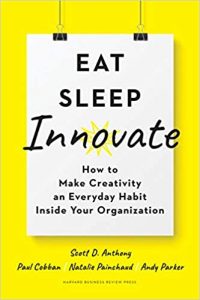An Exclusive Interview with Scott D. Anthony
 I had the opportunity recently to interview fellow author Scott D. Anthony of consulting firm Innosight to talk with him about his new book Eat, Sleep, Innovate: How to Make Creativity an Everyday Habit Inside Your Organization, which is his eighth book with his co-authors Paul Cobban, Natalie Painchaud, and Andy Parker. Congratulations Scott!
I had the opportunity recently to interview fellow author Scott D. Anthony of consulting firm Innosight to talk with him about his new book Eat, Sleep, Innovate: How to Make Creativity an Everyday Habit Inside Your Organization, which is his eighth book with his co-authors Paul Cobban, Natalie Painchaud, and Andy Parker. Congratulations Scott!
1. Given all the innovation books already written (including yours), what did you see missing to make you write another one?
This book traces back to a conversation with a client about five years ago. We were doing a workshop with the top team of a global logistics company, and talking about all of our usual stuff about the need to create organizational space for disruptive innovation and whatnot. The CEO stopped the discussion and said basically, “I’ve read all of your books and we’ve done what you would tell us to do. I have a small team focused on disruption. They are doing great. But what should I do with the 28,000 other people in my organization?” We didn’t have a great answer to the question! In 2017-2018, we did a project for DBS Bank here in Singapore that forced us to push the thinking on the topic, so decided that we would take what we learned, augment it with additional research and case studies, and create a book.
2. Why do behaviors command such a central role in innovation?
Innovation doesn’t happen magically. It happens from people doing things. Much of the innovation literature focuses on the end output, on the strategy, on the supporting organizational structures and processes, but of course all of that only works if people follow certain day-to-day behaviors. One simple way we remind people of this is to return to the basic definition we have of innovation: something different that creates value. You can’t do something different that creates value if you don’t do something!
3. What behaviors are most important to innovation?
There has been good research and writing on this from a range of different scholars and thought leaders. Our synthesis of this work and our own field work suggests that five behaviors are the most critical. It starts with curiosity. You have to question the status quo and ask “What if?” to begin the innovation journey. Next is being customer obsessed. Ultimately, for innovation to take root it must solve a real problem that matters to customers, so great innovators take the time to find problems worth solving, what we call a job to be done. The third behavior is collaboration. One of the most time tested findings in the innovation literature is that magic happens at intersections, when different mindsets and skills collide together. Great innovators recognize that none of us is as smart as all of us. The fourth is being adept in ambiguity. Innovation success comes from trial-and-error experimentation, and requires being willing to fumble, take false steps, and sometimes fail. Finally, innovation requires being empowered. To be a broken record, you can’t do something different that creates value unless you do something!
 4. What are BEANs and why are they important?
4. What are BEANs and why are they important?
A BEAN is a behavior enabler, artifact and nudge. They are important because they get at a hidden barrier to innovation inside organizations: institutional inertia. Let me explain this by describing a puzzle. Over the last 15 years, I’ve watched my four children grow up in parallel to working with large organizations all around thew world. I didn’t have to teach my children to follow behaviors that drive innovation success. Like all humans, they are naturally curious, collaborative, and love to experiment. Yet organizations, filled with people that once followed these behaviors naturally, struggle with innovation. Why? Established organizations focus on doing what they are currently doing better. Innovation is doing something different. Ingrained habits constrain innovation energy. A BEAN draws on the habit change literature to break this inertia and encourage innovation.
5. What makes a successful BEAN?
There’s a basic answer and a more complex answer. The basic answer is that a BEAN engages the two decision making frames that Daniel Kahneman identified in his book Thinking, Fast and Slow: behavior enablers trigger the rational, logical part of our brain where we carefully consider decisions (System 2) and artifacts and nudges trigger the portion of our brain where we make quick, subconscious decisions (System 1). The more complex answer is that a successful BEAN has six criteria. A good BEAN is simple, making it easy to do regularly, practical, lowering barriers to use, reinforced, making it stronger, organizationally consistent, making it natural to do, unusual, making it easy to remember, and trackable, allowing it to be further refined and improved. Yes, those words form the acronym SPROUT. So, a good BEAN needs to SPROUT.
Continue reading the article on InnovationManagement.se

![]() Sign up here to get Human-Centered Change & Innovation Weekly delivered to your inbox every week.
Sign up here to get Human-Centered Change & Innovation Weekly delivered to your inbox every week.